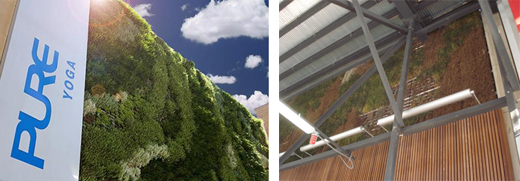Trending
Scaffolding kills life of UES “living wall”
At the time, it seemed like a good idea. When Pure Yoga opened one and a half years ago at 203 East 86th Street, this purveyor of inner peace opted to adorn the upper portion of its two story façade with a “living wall” of plants, in varied shapes and colors, that covered every inch of its expansive surface. It was ably designed by Green Living Technologies. Quite aside from such karmic enhancements as the living wall conferred, it also proved to be a shrewd marketing maneuver. Though not the only such wall in the city, it was and remains sufficiently rare that it was able to garner a good deal of invaluable publicity.
Pure Yoga, however, did not reckon with one of the sad facts of life in the big city — that only the rarest of buildings in Manhattan manages to escape the ubiquitous outrage of scaffolding bridges. And so the living wall had not been up six months when the building it inhabits, the Colorado, decided to do a bit of refacing. The scaffolding went up about a year ago and, as always, it sliced sheer across the second story of the building, entombing the living wall in constant darkness, notwithstanding its precious southern exposure.
For some time, the owners of Pure Yoga held tight, continuing to water the plants through a complicated and costly tangle of pipes built into the wall. But eventually it became clear that they were fighting a losing battle, and there appears to be no end in sight for the removal of the scaffolding. Now, in the resulting wasteland, a few gray and brown tufts of grass continue to cling to the wall, amid the scattered traces of caked earth. Most of the plants, however, have vanished, exposing the metal armature beneath. The living wall is now a dead wall.
As it happens, I have been apartment hunting lately, on the Upper East and West sides. Like most prospective buyers, I knew which features I definitely wanted and, as important, which I would not be able to live with. In the latter category was the refusal to inhabit a second story apartment. In other cities around the nation and the world, there would be no problem. But the reality of Manhattan is that the second floor is the new ground floor, and the ground floor is the new basement, thanks to the ubiquity of scaffolding bridges. I wonder if it has yet filtered into the thinking of prospective buyers and renters of second-floor apartments that for a good portion of their tenancy, much, if not all, of their light will be blocked, together with any view out their window. In compensation, they will have the company, at least during the daylight hours, of hard hats plying their trade barely two feet away, just outside the window.

From left: Pure Yoga’s “living wall” at 203 East 86th Street, as it was intended, and wall today, after scaffolding was installed (right photo source: A Fine Blog)
All of this is the absurd consequence of two bad and thoroughly thoughtless laws, Local Law 10, passed in 1980, and Local Law 11, passed in 1998, that mandated these ugly and largely useless sheds. You won’t find them in anything like the same abundance in Paris, Berlin, London or Hong Kong, and yet it is not evident that the imperiled citizens of those metropolises are dying left and right. Meanwhile, you can no longer look in any direction on the Upper East or West sides, in Midtown or the Financial District, without seeing these scaffolding bridges. Nor is it possible any longer to walk with pleasure down Park Avenue — unless you enjoy the constant interruption of these sheds that are so efficiently destroying the urban fabric of New York City.
James Gardner, formerly the architecture critic of the New York Sun, writes on the visual arts for several publications.




